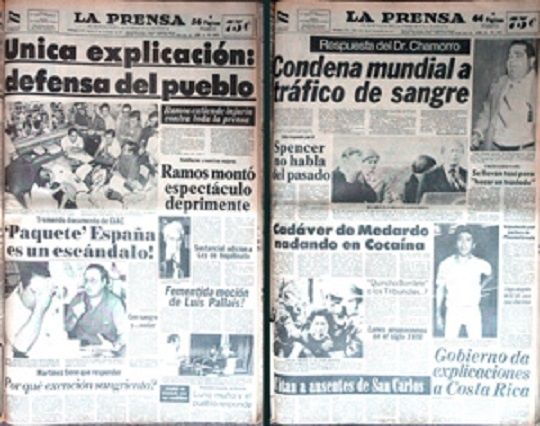While Nicaragua suffered scores of human rights abuses under the decades-long Somoza dictatorship in the leadup to the Sandinista Revolution in 1979, the Somoza family was also simultaneously involved in a little-known but shocking business venture exploiting poor Nicaraguan people: literally sucking their blood to sell for hefty profits in the United States.
OPINION:
Nicaragua's July 19 Anniversary: Celebrating Revolution in Latin America
The aptly-named company Plasmaferesis was launched in Nicaragua in the 1970’s by Pedro Ramos, a right-wing Cuban doctor who left the country after the Cuban Revolution brought Fidel Castro to power. The company bought blood on the cheap from poor and desperate Nicaraguans, separated and froze the plasma, and sent it to Europe and the United States, raking in huge profits.
The Somoza regime was directly linked to the shady business. Anastasio Somoza — the last of the Somoza dynasty to rule the country before his overthrow in 1979 — and his son were both part owners of Plasmaferesis, according to historical accounts of the era published in the 1980’s. The firm also ran its operations on Somoza-owned property in Managua.
Adding to the controversy, Somoza was peddling Nicaraguan blood abroad at a time when the poverty-stricken country needed donations most after a devastating earthquake hit Managua in 1972. The disaster left some 6,000 people dead, 20,000 injured, and over 250,000 homeless. Medical supplies, including blood transfusions, were in short supply.
Leeching Off Intense Inequality
The Nicaraguan newspaper La Prensa, the most prominent opposition voice that criticized the Somoza dictatorship, broke the scandal in 1977 in a series dubbed the “Vampire Chronicles.” According to the Nicaraguan newspaper El Diario Nuevo, founded in 1980 by a breakaway group of La Prensa staffers, the Plasmaferesis exposé was among the dictatorship-era coverage that most repulsed the society and “devastatingly impacted Somoza.”
“It was a dark business,” former La Prensa journalist Roberto Sanchez Ramirez told El Diario Nuevo in 2008. “Every morning the homeless, drunks, and poor people went to sell half a liter of blood for 35 (Nicaraguan) cordobas.” In 2016, 35 cordobas is less than US$1.25.
OPINION:
Whatever Happened to Nicaragua's Right-Wing Opposition?
Sanchez Ramirez added that the business only existed in Nicaragua and Haiti — the two poorest countries in the Americas.
According to reports published at the time, Plasmaferesis’ health standards were dismal, and the clinics would take blood from the same person up to twice a week if they showed up to sell. While health experts suggest that blood plasma is replaced in a matter of days, the body needs more than 30 days to recuperate a normal red blood cell count.
Late Philadelphia journalist Jack McKinney reported in 1990 that the business “thrived on the social inequities of Somoza’s economy” and in the process, made a killing in profits.

La Prensa's Plasmaferesis coverage. I Source: El Nuevo Diaro
“Ramos was the single most prosperous exporter of human blood plasma in the Western Hemisphere,” wrote McKinney. “His donors were desperately poor people, who were paid a pittance for their blood at a private clinic the locals referred to contemptuously as La Casa de Vampiros, or ‘The House of Vampires.’”
According to Douglas Starr, author of “Blood: An Epic History of Medicine and Commerce,” Nicaragua was “the developing world’s largest plasma collector” in the 1970’s, taking blood from up to 1,000 people per day at its peak.
A Bloody Legacy — In More Ways Than One
Less than three months after the Plasmaferesis scandal broke thanks to a mother who went public after her son didn’t return home from a trip to sell his blood, La Prensa editor Pedro Joaquin Chamorro — previously jailed several times over his opposition to the dictatorship — was assassinated by unidentified gunmen on Jan. 10, 1978.
Somoza claimed Ramos, the chief owner of Plasmaferesis, was the mastermind behind the killing. But Chamorro’s family and other members of the opposition held the dictatorship directly responsible.
OPINION:
In Nicaragua 37 Times 19 Equals Democracy, Dignity and Justice
Chamorro’s murder — possibly ultimately tipped off by the Plasmaferesis exposé that dealt a blow to both Ramos and Somoza after the editor long claimed there were plans to assassinate him — added fuel to the fire of the mounting resistance against the dictatorship. His funeral, attended by some 30,000 people, erupted in riots in the streets of Managua.
The growing movement ultimately led to the overthrow of Somoza by the Sandinista National Liberation Front, or FSLN, on July 19, 1979. Chamorro’s wife Violeta Barrios de Chamorro was a member of the Sandinista-led junta during the the first years of the U.S.-backed Contra War from 1979 to 1980. She later became the country’s president in 1990.
Meanwhile, Somoza, whose regime oversaw widespread human rights abuses in his attempt to crack down on the Sandanista rebellion — including torture and extrajudicial killings — fled to Miami, and later to dictator Alfredo Stroessner’s Paraguay, where he was assassinated in 1980.
Ramos, on the other hand, took refuge in Miami, where he died. He was tried in absentia and found guilty of murder after the Sandinista Revolution, but he never returned to Nicaragua to face his bloody past.